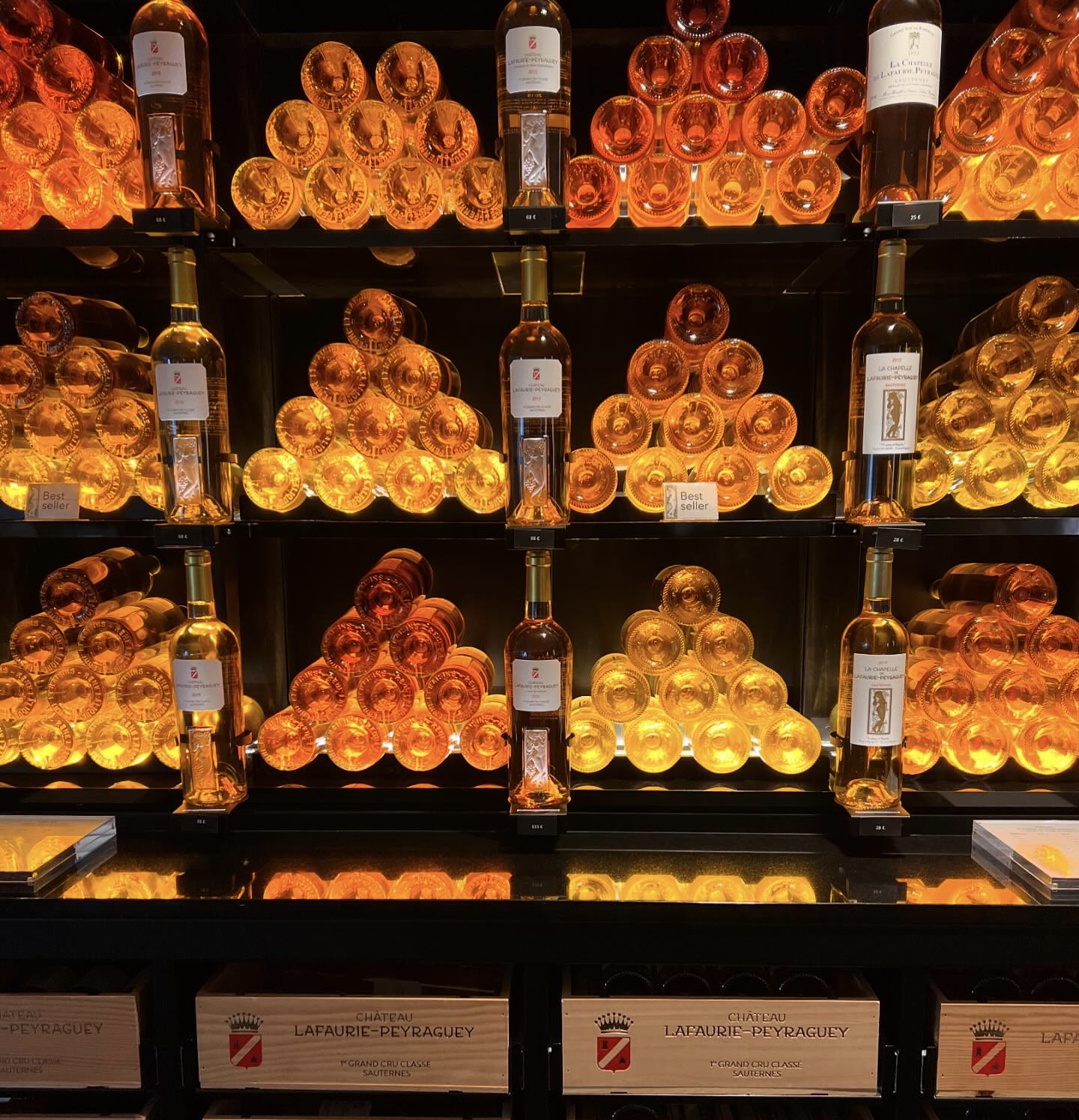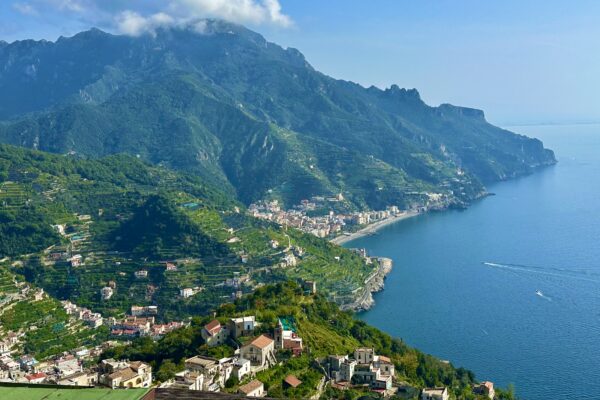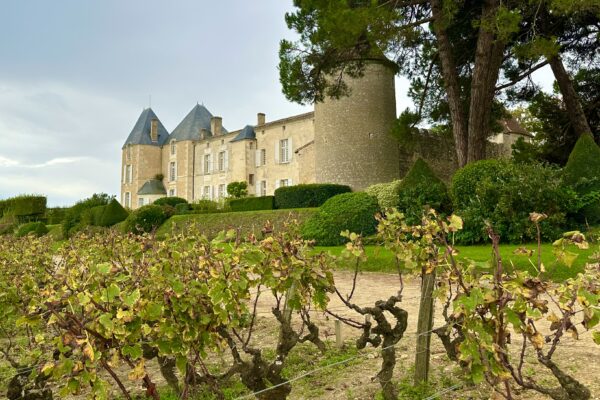The Miracle of Sauternes: Châteaux d’Yquem & Lafaurie-Peyraguey

by Marla Norman & Michel Thibault
On our most recent trip to Bordeaux, we were thrilled to tour the legendary Château d’Yquem and to attend a lunch hosted by Pierre Lurton, LVMH (Louis Vuitton Moët Hennessy) Chairman of the board for Château d’Yquem as well as Château Cheval Blanc.
Yquem dates back to the 1300s, however, the Château had no vineyards until 1711, when Léon de Sauvage d’Yquem began planting vines. In 1785, his great grand-daughter, Joséphine de Sauvage d’Yquem, began managing the property. In one of the most significant milestones for Yquem, Joséphine discovered the role of Botrytis Cinerea (Noble Rot) and began vinifying the first modern Sauternes. (Michel has provided a summary of that process later in the article.)
Eventually, Joséphine’s grandson Romain-Bertrand de Lur Saluces, took over management of the estate in 1851. A few years later, in 1855, Yquem was judged “Premier Cru Supérieur” or First Growth in the Grand Cru Classification of Bordeaux. In 1996, LVMH bought the estate. The last owner, Comte Alexandre de Lur-Saluces stayed on as manager until 2004 when he retired and was replaced by Pierre Lurton.
We try to absorb all this history as we walk the massive 300-acre estate. Vineyard teams labor to harvest the last of the 2024 vintage, while flatbed trucks with baskets of carefully-selected grapes fly in and out. After being received, the berries are fed into a crusher and on into tanks.
Promptly at noon, everyone breaks for lunch and we file into the salon, hesitating to sit on the museum-quality 15th century divans and settees. The welcoming staff puts us at ease and offers hors d’oeuvres accompanied by “Y” 2017 – the Sauternes Sec produced at Yquem. A blend of 75% Semillon and 25% Sauvignon Blanc, the wine is beautifully perfumed, honeyed and unctuous. A spectacular start, needless to say.

Elegant salon at Château d’Yquem. Photo by Marla Norman.
A few minutes later, Pierre Lurton arrives. We were expecting an LVMH Chairman to be stuffy and uptight, but he’s casual and gracious with a marvelous sense of humor.
Pierre ushers us into the elegant dining room and we’re served the first course: lobster in a citrus sauce, topped with caviar and accompanied by Yquem 2021. We wonder if the Sauternes might overwhelm the delicate lobster and citrus flavors, but in fact they blend seamlessly and add balance to the deliciously briny caviar.
The next dish is roasted guinea hen over mushrooms with potatoes and sautéed apples on the side. Again, we’re startled at how perfectly the Sauternes — in this case a 2013 Yquem — not only pairs with the flavors, but actually completes the dish.

Chef Olivier Brulard, winner of the 1996 “Meilleur Ouvrier de France” (Best Chef for Artisan Cuisine in France). Photo by Marla Norman.
As we enjoy the food, Pierre repeatedly praises his chef, Olivier Brulard, who in 1996 won “Meilleur Ouvrier de France” (Best Chef for Artisan Cuisine in France). Brulard has been in charge of the kitchens at Château d’Yquem for a number of years and is a master at pairing Sauternes. “Yquem is my favorite restaurant in France,” Pierre asserts. We heartily agree!

Our cheese course provided by Dominique Bouchait, MOF Fromager.
For the cheese course, we are served a Roquefort produced by Dominique Bouchait, MOF Fromager (Meilleur Ouvrier de France or Best Artisan in France for Cheeses).
A 1983 Yquem accompanies the dish. Suddenly Pierre leaves the table, seemly alarmed. He tastes and retastes — “Something’s off,” he says, but tells the staff to pour. We taste and think it’s fabulous. But, Pierre’s not happy and asks for a bottle of 1954. We’re blown away. What a finale!!!

Our tasting: “Y” 2017, Châteaux d’Yquem 2021, 2013, 1983 & 1954. Photo by Elaine Portannese.
MICHEL’S WINE NOTES
Château d’Yquem 2021 – Two-thirds Semillion and one-third Sauvignon Blanc make up this 100-point baby. While super young, it delivers beautiful fragrances of tropical fruit: papaya, mango, Meyer Lemon, as well as saffron and vanilla. I would love to revisit this wine in 15 years.
Château d’Yquem 2013 – A modern version of perfection. Sweetness was never an issue. The wine was more like a color marker highlighting the important characters of the dish. What a masterpiece!
Château d’Yquem 1983 – This vintage was ranked #9 in the Wine Spectator Top 100 in 1988, described as “full-throttled, elegant and stylish.” Seemed pretty perfect…but who are we to argue with Pierre Lurton!!!
Château d’Yquem 1954 – Everything you could ask for: voluptuous, dreamy, savage, providing different sensations at every sip. The color was a sensual golden brown, like the forest just outside the Château. The wine was peaking that day. What a moment! And yet, I’m reminded of a famous wine critic (no need for name) who gave this 1954 an 89 points rating. Unbelievable. Like thinking a Targa Florio Porsche or a Ford GT 40 are just ok to look at.
What we learned: Yquem, top Sauternes and Barsac, Tokaji and Monbazillac are not just dessert wines but rather wines that can match an amazing array of gorgeous, savory foods. Looking forward to lots of tasting in the near future.

Michel & Marla with Pierre Lurton, LVMH Chairman of the board for Château d’Yquem & Château Cheval Blanc.
MIRACLE IN A BOTTLE
Now that we’ve hopefully whet your appetite for Sauternes, here’s a quick overview for how they’re produced. Most importantly, the region’s geography is essential to this unique wine. The Ciron, a cold water river flows into the Garonne, a warm river, the resulting effect is dense fog over the area. Each Autumn, when grapes are ripe and almost ready for harvest, this fog wets the grapes in the morning. Later, in the afternoon sun, the grapes dry.
This wet-then-dry action repeated daily, creates a mold on the grapes, Botrytis Cinerea or Noble Rot. The grapes shrivel, gain concentration and aromatic richness. That is the miracle of Sauternes because the resulting wine is a lush, gorgeous combination of exotic fruit, cedar and vanilla flavors, all surrounded by an incredibly glossy texture.

Technical teams at Château d’Yquem bringing in the last of the 2024 harvest – precious berries with perfect Botrytis Cinerea or Noble Rot. Photo by Marla Norman.
The varietals used to make Sauternes (and Barsac, a smaller appellation within Sauternes) are Semillon, Sauvignon Blanc, Sauvignon Gris and to a lesser extent Muscadelle. Semillon offers depth, roundness and glossiness with rich tropical tones while Sauvignon Blanc and Gris give the freshness that keep Sauternes from being too heavy. A match made in Heaven!
Of course, grapes are picked by professionals who know exactly what to seek: since the rot is not uniform on a grape bunch, single grapes have to be pulled from the bunch (similar to picking Spatlese, Auslese, etc. in Germany and Austria). The work is intensive, brings very little yield and of course a team of pickers often harvests six or seven times to obtain the perfect grapes. I have heard of 10 to 11 passages through the vineyard to finish harvest. Insane and incredibly costly!
Moreover, only a very small percentage of grapes make it into the first wine, while others are sold as basic Sauternes. In some years the climactic conditions are not good for making Sauternes at all. Typically Yquem will produce about 65,000 bottles, but in a poor vintage the entire crop will be declassified and sold anonymously. Next time you taste one of these jewels, marvel at the amount of work there is in that bottle.
CHÂTEAU LAFAURIE-PEYRAGUEY
To learn more about Sauternes, or to just enjoy a luxurious retreat in the Bordeaux countryside, spend a weekend at Château Lafaurie-Peyraguey. Once a military fort built in the 13th century, the Château has now been converted into an exclusive 5-star hotel (13 rooms only) with a two-star Michelin restaurant. The owner responsible for all these changes is Silvio Denz, owner of Lalique. Indeed, with over 3,000 glass pieces in the hotel and restaurant, the property is a crystal fantasy.

Château Lafaurie-Peyraguey, a Premier Cru Classé estate that is also a five-star hotel. Photo courtesy of Château Lafaurie-Peyraguey.
The second Michel and I walk through the exquisite lead crystal doors, we know we’re in for a rare treat. While our room is readied, we’re directed to the bar, which is filled with beautiful bric-a-brac and intricate chandeliers. Champagne is served from ethereal crystal glasses.

The reception-bar at Château Lafaurie-Peyraguey, filled with Lalique treasures. Photo by Marla Norman.
Our room has a superb view of the vineyards framed by enormous windows with heavy crystal latches. Closets, drawers, faucets, etc are all dazzling Lalique. Of course, the light fixtures and sconces are sparkling glass art as well. We sit for awhile just taking it all in.
Outside, the well-tended grounds and vineyards are equally lovely, if in a more down-to-earth way. Château Lafaurie-Peyraguey is a Premier Cru Classé property with just over 44 acres. We hop on electric bikes provided by the estate to explore the vineyards. Closest to Lafaurie-Peyraguey is Château d’Yquem. Also nearby are Châteaux Guiraud and Sigalas-Rabaud. It’s a very nice neighborhood!

Glass art on display at the Château Lafaurie-Peyraguey Boutique & Museum. Photo by Marla Norman.
Later, we stop by the Lafaurie-Peyraguey Boutique which also houses the Lalique Museum. René Lalique began his career as a jewelry apprentice at age 16. A gifted artist, he quickly became known for his original creations and went on to become one of France’s foremost Art Nouveau designers. Marc Lalique took over for his father in 1945 and expanded the company business to lead glass crystal. Currently the Lalique Group is owned by Silvio Denz, an investor and art-wine collector based in Switzerland.
That evening, we have dinner in the Michelin two-star Restaurant Lalique. As the name suggests, glass art shares top billing with the cuisine. The dining room, designed by Mario Botta, dazzles with a ceiling decorated with one hundred and twenty Semillon leaves in gold crystal. Additionally, each table has a unique Lalique statuette and, of course, plenty of crystal glasses and tableware. In a word – stunning!

Restaurant Lalique is a Michelin two-star, which lives up to its name – 120 Semillon crystal leaves light up the ceiling and Lalique statuettes decorate every table. Photo courtesy of Restaurant Lalique.
Chef Jérôme Schilling has designed seasonal menus — all revolving around Sauternes and vineyard products. As Schilling tells us, “It is all about bringing out the qualities of Sauternes in precise gastronomic pairings, enhancing its aromas, highlighting its various shades and playing with textures.”
Our menu features an “Interpretation of Vintage 2011.” We begin with a Langoustine Kalamansi – tiny wildflowers decorate the seafood in the most incredibly delicate plating — too precious to eat. But of course we do and savor every mouthwatering bite.
A Candied Hake with Bergamot and Elderflower follows. Chef Schilling describes the technique he uses to cook down the Hake with grape seed oil as again, emblematic of his “Cuisinier des Vignes” (Cooking within the Vineyard) philosophy.

A classic dish at Restaurant Lalique: Candied Hake with Bergamot and Elderflower. Photo courtesy of Restaurant Lalique.
Up next is a Veal Chop with sautéed Spinach in a Yuzu Sauce — an opulent, sumptuous dish with Asian spice and citrus flavors. The Yuzu Sauce and Sauternes make the dish something exotic and truly out of the ordinary.
The final dish is a braised strawberry tart with lemon, thyme and marjoram. Chef Schilling tells us that he was inspired by his favorite childhood dessert. It’s a memorable finish to a remarkable meal.

A Braised Strawberry Tart to top off the meal. Photo courtesy of Lalique Restaurant.
And at Château Lafaurie-Peyraguey, it seems especially appropriate to enjoy the last of our Sauternes while watching the sun fade in a prism of colors through shimmering Lalique crystal.

Sunset at Château Lafaurie-Peyraguey accompanied by Lalique crystal. Photo by Marla Norman.
MICHEL’S WINE NOTES
Before making our reservation at Restaurant Lalique, we had read about the extensive wine list the restaurant offered. Apparently, most of the wines are from the personal collection of Silvio Denz, the owner of Lalique Crystal and of Château Lafaurie-Peyraguey. Upon reading the “wine book” I was impressed by the depth of appellations and vintages available.

Over 2,500 bottles are on the wine list at Restaurant Lalique, most from the private cellar of Silvio Denz. Photo courtesy of Château Lafaurie-Peyraguey.
With the menu selection, I was tempted to opt for a white Burgundy, maybe spend more than I should on a 1er Cru Puligny by Domaine Leflaive. However, the selections included some older vintages which scared me a bit — Everyone talks about the pre-mox years (premature oxidation) that affected many wineries in Burgundy. Not everyone agrees as to the cause of this problem, but it is a fact that quite a few wines can taste flat, done.
Back to our wine selection…There was a Domaine Leflaive Puligny Montrachet 2016 and we went with it. Smart decision — the wine was bright, lively, with exotic fruit aromas, white flowers and that Asian feel so common to the great Puligny. Exactly what I had in mind to match the food on the Menu.

Jérôme Schilling, head chef of Restaurant Lalique, has received the Meilleur Ouvrier de France.
For the red, we chose a Silvio Denz property from the right bank: Château Péby Faugères 2006. It should actually be called Château Faugeres, Cuvée Peby as it is a special Cuvée from Château Faugères. We were looking for a wine with density, ripeness and good juice, but also a wine with integrated and sophisticated tannins that delivered dark wild fruit and beautiful roundness. We grabbed that bottle exactly at the right time….with the veal chop!
Bravo, Restaurant Lalique for superb selections. We hope to return soon!
See more of our wine travels here: Saint-Émilion and Pomerol.







